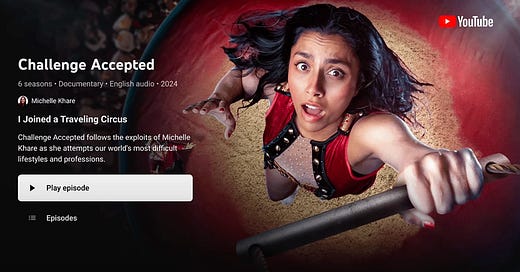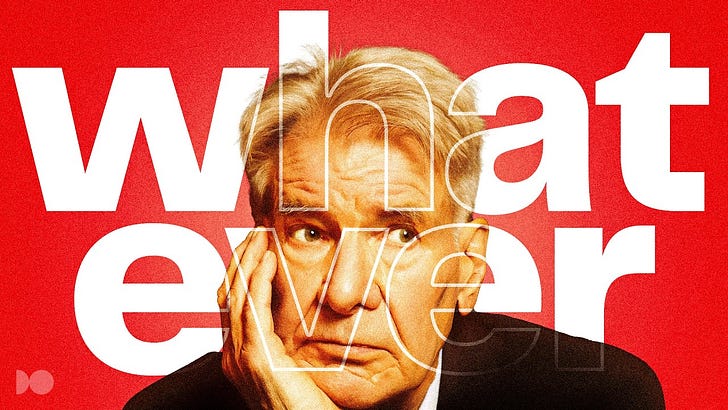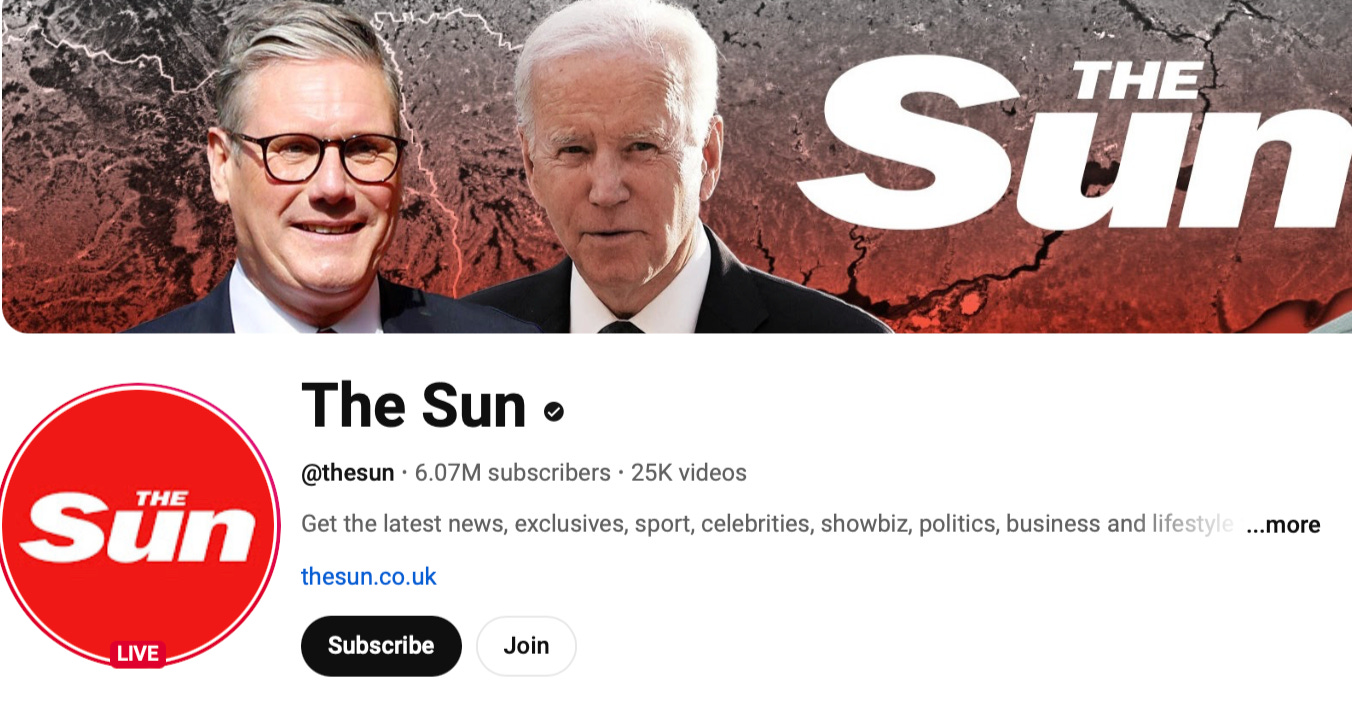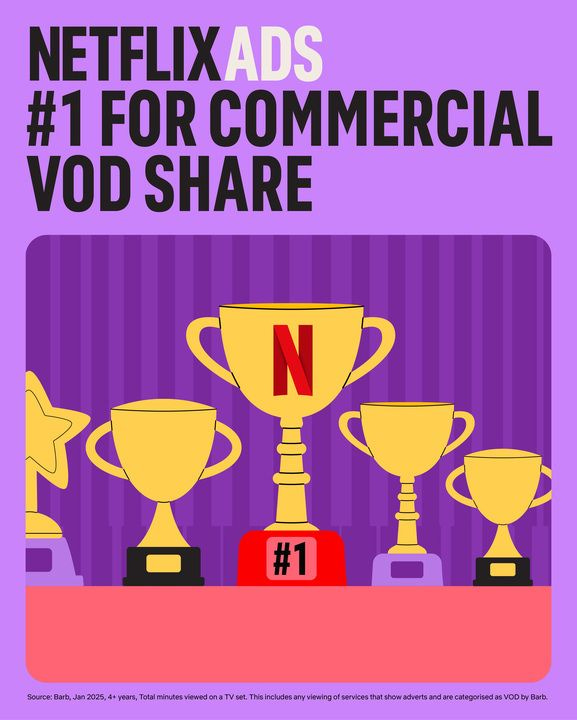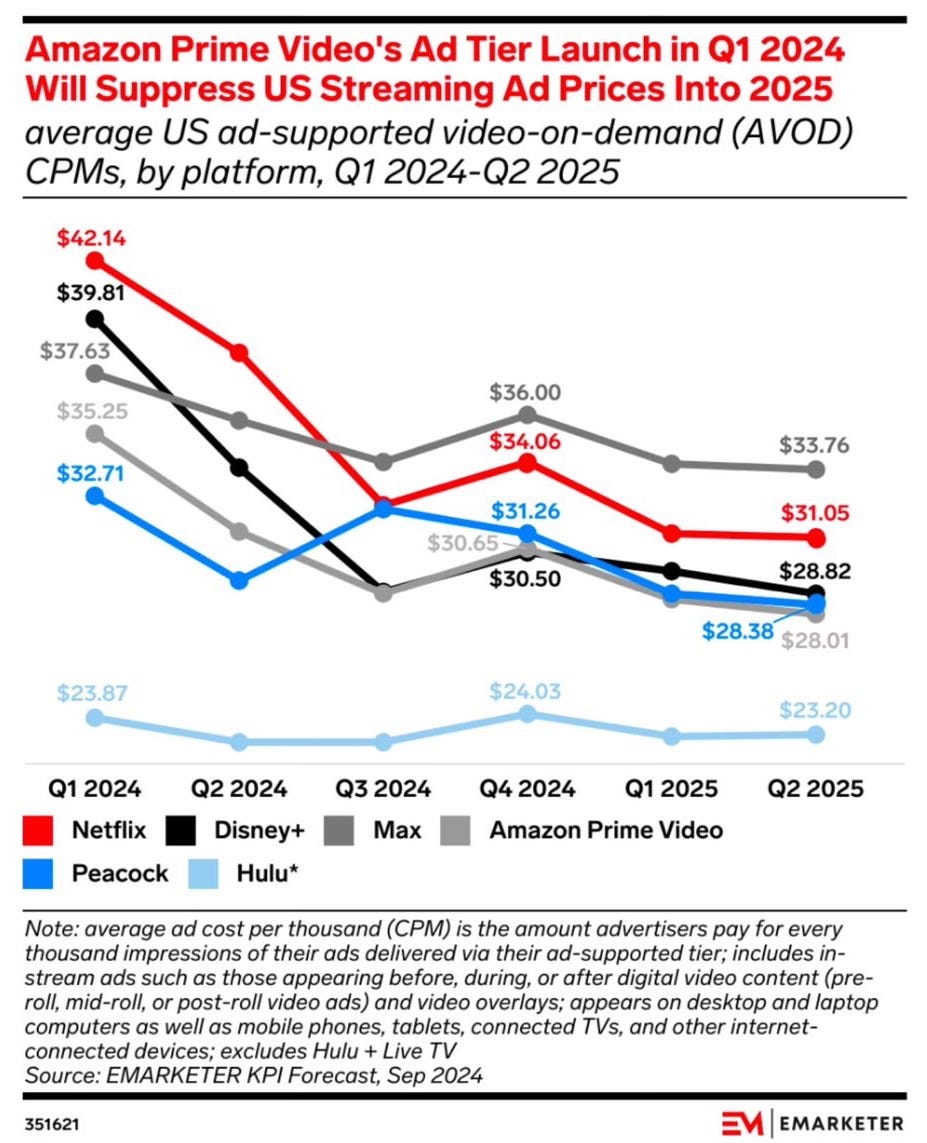TV & YouTube and the tricky issue of clearances
Plus The Sun's video strategy; more evidence of TV & YouTube merging; and Netflix's share of the UK ad market
Before jumping in, as mentioned I’ve started a second email where each week I collate together a whole bunch of YouTube examples on different themes and genres to hopefully inspire you.
It is only for paid subscribers, and I did say I wouldn’t send it to you in the future if you are a free subscriber. However, a few people have said they’d like to get it anyway, even if they aren’t a paid subscriber.
So in the spirit of audience research and doing what is useful, can I ask which you’d prefer? If you are a free subscriber, would you like the two emails each week, even if one of them is behind a paywall, or would you like only to receive the one free email? Hopefully this makes sense and isn’t as clear as mud…
Thank you - and so on to the things that I’ve been pondering this week.
How clearances work online compared to TV production
Speaking of that new second email, hopefully you have received the first one which has long list of documentary creators.
One pretty major elephant in the room I haven’t really mentioned thus far is clearances; after all, many YouTube creators are often using all sorts of archive material that doesn’t appear to have been cleared in the usual way it works for TV.
I’ve been asked this week by a few factual TV producers how this is possible?
To explain. Some of the clips won’t be picked up by YouTube’s content ID system - the fingerprinting technology that runs across all uploaded content looking for copyrighted music, audio and video. This could be because of one of three reasons:
The clip is under 30 seconds and therefore content ID might not spot it
The original material hasn’t been fed into the content ID system by the IP owner
The creator has altered the clip that means content ID isn’t recognising it - freeze frames, removing audio, perhaps an overlay of some sort.
There is also a fourth reason, which is a legal defence such as fair use. As a general explainer (with the caveat I’m not a copyright lawyer): since the internet was invented it has always been common for users to look to the defences of fair use, fair dealing or review and criticism when using copyrighted material online. Indeed, if you browse Reddit conversations you’ll often find users discussing what they understand to be permissible under these laws.
However, this is where the global nature of online platforms can come crashing into the reality of different laws by territory: as an example, the US’s doctrine of fair use is generally broader than the UK’s concept of fair dealing. And from previous experience working with great lawyers inside UK broadcasters, it has often been the case that users’ understanding of these defences can be fairly expansive when compared to a copyright lawyer’s more informed and narrower interpretation of what is reasonable under the law. As this University of Edinburgh explainer outlines:
A similar concept - ‘fair use’ - exists in the US but it is a general defence. The UK 'fair dealing' is more limited than the United States doctrine of fair use. The terms ‘fair use’ and ‘fair dealing’ are not interchangeable - an exception that applies in the US may be regarded as an infringement in the UK.
Here is a useful post explaining the UK law on fair dealing, and also here is a post by YouTube on copyright.
The upshot of all of this is that for creators, this is a grey area. It could be a risky business if at some point an IP owner decides to come chasing, especially if this results in copyright strikes within YouTube which can damage a channel’s performance. However, individual creators might think that is a risk worth taking as either they have a fair use/fair dealing defence, or the IP owner may decide to allow the continued use of copyrighted material via the content ID system - for example, some movie studios have long viewed clips being used on social platforms as marketing.
As YouTubers become more mainstream and successful, the more they might bump up against these tricky legal issues. However, one thing is likely, videos from YouTube that haven’t got these clearances in place simply couldn’t or wouldn’t be broadcast on TV or a streamer, no matter how good they are. After all, for archives, clearing for broadcast is big business. And in turn, if these fees were applied to creator-land, well, the financials might look fairly different pretty quickly.
The great merging: TV embracing YouTube and vice versa
This week, Business Insider had a timely piece about how producers are embracing YouTube:
It includes a little on Fremantle’s YouTube strategy, which now has 1,500 channels with a combined total of 32bn views across YouTube and Facebook. They’re also investing in YouTube originals, including a video podcast ‘High in the Sky’ by one of their companies, Original Productions.
The Information is also reporting that YouTube is going to (continue) to redesign its interface to be more like other streaming services - remembering that 50% of viewing of YouTube is on the TV. At the moment, you can buy or rent TV series, films and access to channels via a specific tab on YouTube - see below:
However, in the next few months, it is understood that content from paid services will be incorporated into the homepage and the overall YouTube experience. Kurt Wilms from YouTube is quoted in The Information:
The vision is that when you come to our TV app and you’re looking for a show, it’ll just blend away whether that show is from a Primetime Channel or that show is from a creator.
Remembering back in September 2024, Google announced that creators could organise their content into seasons and episodes to make it easier for views on connected TVs - visually, this is looking more and more like Netflix.
A few more examples of this merging of TV and YouTube. Listening to Colin & Samir recently, they shared an example of creator Tejas Hullur who spent six months creating a TV documentary-like format ‘How to Become More Attractive, Scientifically’. The episodes themselves feel telly-like, as does having a trailer and a weekly publication schedule, plus his thumbnails look fairly similar to something you’d see on Netflix.
And another example from this week - PrestonGoes (830k subscribers, 249m views) has a channel all about engineering projects. Over the last six months, he produced 3 x 30 episodes on building a mini truck for abandoned railways.
According to Colin & Samir, he spent $15k on building the truck as well as the episodes which he shot, produced and edited himself. In the first five days, the first episode has had 2.2m video views, which will have (approximately) generated around £12k (which is $15k) in ad income net of YouTube’s share.
Obviously it is tricky to make a direct comparison - it is his own money, so Preston may not have paid himself, and also perhaps he won’t have had much in the way of crew or post costs. Never mind that TV productions have all sort of other costs such as health and safety requirements, compliance, commissioner viewings and so on. However for Preston as an individual, these three videos will sit there for years, racking up ad income, long after he’s moved on to other things.
What is clear is that many creators are avidly watching professionally produced TV which then inspires them to tailor this understanding to YouTube. So for TV producers looking to work into YouTube, they too should be obsessively understanding the YouTube platform and environment in return.
One to watch: The Sun and YouTube
On the list of companies with interesting strategies in this time of great upheaval, then The Sun and its News Corporation bedfellow Fox are both ones to watch. I’ve written previously about Fox: Its strategy with free ad supported streamer Tubi, as well as how financially it is in better shape that other legacy media companies - in part because they didn’t try to slug it out in the subscription streaming wars (although are now planning on launching a sports/news focussed subscription streamer later this year).
As for The Sun, their YouTube strategy is one to track. They engaged Sam Barcroft and the team at Creatorville, as well as people like Jon Eastman to draw up a new video and YouTube strategy. And it was announced recently their new director of video is Jon Lloyd, who previously has worked in fact ent and on formats like Come Dine With Me.
Press Gazette: Sun names director of video to lead new strategy
Press Gazette: How The Sun became biggest UK newspaper on Youtube with 6 million subscribers
As well as breaking stories, The Sun on YouTube has two other pillars - news and originals. The director of digital Will Payne is interviewed in the second Press Gazette piece above:
Sun Originals is described by Payne as a “top-to-bottom production house, in-house, of highly sponsorable episodic content”. New shows are expected to launch in the coming weeks.
This strand will initially focus on Sun Sport and Fabulous “because they’ve got great brand identity, real audience need, they’re two of our best performing sections, and they’re brand safe so we can create really fun and formats to take out to market”.
One of the appeals of YouTube is the ability to build a global audience which makes the economics of content production much more healthy. And for some news brands, the ability to make this journey from national to global player is easier. As an example, from around 2016, Channel 4 News shifted its social video from publishing a high volume of packages and interviews from its TV output with the goal of driving users to its website, and instead focussed on creating online-only videos that would appeal to a global niche audience that found their brand and attitude appealing. As a result, they published less content, and what they did create were videos tailored to the interests and sensibilities of these users. The result was that their video views went from around 80m per year to 2bn - obviously helped along by the news agenda at that time. Also worth noting, these views were across all social platforms, and at that time Facebook had been more of a priority than YouTube.
For some news organisations, despite a desire to become a globally recognised brand, the journey is much harder. On that point, in 2023
wrote this great piece about the New Statesman’s ambitions to become an international online publication, perhaps in the same vein as The Atlantic.Anyway, back to The Sun. Running a few numbers against a potential competitor set, and you can see there is quite a battle going on for attention on YouTube with a lot to play for - especially for those news brands that can have global appeal.
There are a few interesting details in these figures. For example, despite similar subscriber numbers, over the past 90 days BBC News has had half the views compared with CNN. This could be explained by the goings on in the US’s political landscape, however BBC News were also pipped on views by Sky News in the same time frame. And look at The Telegraph - more subscribers than the Daily Mail and in 2022 had more lifetime views than CNN, the Daily Mail and the Guardian. Interestingly, as part of their new YouTube push, The Sun has also just hired the Telegraph’s head of video news.
You can also see how TV and news publisher operations have grown less in terms of views over the past three years when compared with some of the new individual challenger brands like Megyn Kelly or Piers Morgan, both of which are more of a talk show video podcast format than packaged videos.
In January it was announced that Piers Morgan’s own company would take control of his channel from News UK, who had previously launched it in November 2021 as part of the TalkTV venture (thus explaining the enormous growth percentage above).
Similarly, Megyn Kelly also has recently been commenting on her channel’s growth. She did an interview with Ben Smith from Semafor, where she said: “Last month on CNN’s YouTube feed, they had 155m views and we were 147m … Just me and my six producers versus every single show on CNN … The month of November, I beat all of them.” Worth noting her channel is also connected to her SiriusXM radio show.
As an aside, this piece by Nic Newman for Oxford’s Reuters Institute is worth a read on the phenomena of individual news influencers:
Obviously the cost base and proposition of an individual’s YouTube channel is completely different compared to running a 24 hour TV and online news operation, however both of these examples do illuminate why brands like The Sun are investing heavily in building global audiences through YouTube.
With more YouTube subscribers than any of the other UK’s newspaper brands, and more growth in the past three years in comparison to the Daily Mail, it will be interesting to see how The Sun’s originals strategy shapes up compared with the bread and butter that is breaking and daily news.
Netflix and share of the ad market
Warren Dias, MD of Netflix Advertising in the UK, recently posted the following on LinkedIn:
According to Barb data, Netflix Ads had the largest share of TV viewing among commercial VOD services in the UK in January. This means that over 20% of the total time spent viewing all commercial VOD and BVOD players was on Netflix Ads. Incredible, right?
Netflix Ads' reach of 8.9 million unique viewers and MASSIVE engagement (over 20 hours of viewing per average viewer in January) earned us the top spot.
This is great news for Netflix, especially as their advertising tier is opt in rather than opt out. Remembering that Amazon did the opposite - moving all 220m global subscribers into their ad tier which had a knock on effect on streaming advertising prices. See the recent US graph below from eMarketer:
For commercial broadcasters like All4 and ITVX, the news that Netflix is taking a big slice of VOD ad revenue must be less great in what is already a challenging market.
YouTube Playables
On the regular theme of platforms trying to get you to spend more time with them, it is worth noting that YouTube quietly last year got into gaming with the launch of YouTube Playables - an arcade of minigames that it began testing the previous year. Launched in May 2024, it includes games like Minesweeper, Cut the Rope and Angry Birds.
For publishers, streamers and music services such as YouTube, Spotify, New York Times and Netflix, games, puzzles, video podcasts are being added to encourage longer dwell time and more engagement from their users and subscribers. Even LinkedIn has games - and according to the blurb, they are there to help us sharpen our minds…
Other interesting reads
Bloomberg: Dude Perfect creates a real world venue for its YouTube antics
The Hollywood Reporter: How Streaming Is Making Us All Cinema-Illiterate
Deadline: Hulu’s Oscars Live Stream Cuts Out Right Before Night’s Final Two Big Awards
Friday’s Espresso: London TV Screenings from
.
That’s it for this week - drop a comment below if anything sparked a thought!
Find out more about me and the purpose of this newsletter, say hi via email hello@businessoftv.com, or connect with me on LinkedIn.


